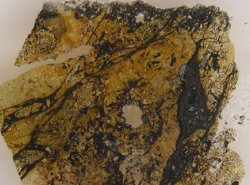
December Editorial
Bridgmanite, the most abundant mineral in Earth

December Editorial
Bridgmanite, the most abundant mineral in Earth
|
|
One of the most frustrating things for a scientist is to know that something he wants to study is there but he can't get to it. This has long been the case with a variant of magnesium iron silicate (MgSiO3), now known as Bridgmanite. For decades scientists have known that this high density MgSiO3 constitutes a large portion of lower mantle. Indeed scientists now believe that this particular mineral makes up about 38% of the Earth's volume. Rare it is not. |
This high density MgSiO3 has a so-called perovskite structure. Perovskites take their name from the mineral first discovered in the Ural mountains of Russia by Gustav Rose in 1839, and the discovery is named after Russian mineralogist L. A. Perovski (1792–1856). The general chemical formula for perovskite compounds is ABX3, where 'A' and 'B' are two cations of very different sizes, and X is an anion that bonds to both.
However while Bridgmanite is abundant, it is also inaccessible. The problem is that high density MgSiO3 is only stable under extreme pressure and temperatures. That is, in conditions found only deep inside the Earth. To remain stable Bridgmanite requires a pressure roughly 240 thousand times greater than air pressure at sea level, and a temperature of about 2100 degrees centigrade (3800 degrees Fahrenheit). When released to the surface Bridgmanite becomes unstable and impossible to study.
But ancient meteorites and novel techniques have come to the rescue. The meteorite in question is Tenham L6 chondrite which fell in 1879 near Tenham Station in Queensland Australia. When studying the chondrite in the Tenham L6 meteorite, Oliver Tschauner, a mineralogist at the University of Las Vegas, and his colleagues realized that they had finally found a sample of MgSiO3-perovskite which they could study.
Shock-compression occurs in collisions of asteroid bodies in the solar system, and this creates the same hostile conditions as those found in the deep Earth. However the shock occurs fast enough to inhibit the Bridgmanite breakdown that takes place when the mineral is slowly brought to a lower pressure, such as by being raised to the Earth's surface. In the meteorite, Bridgmanite was therefore preserved in its native form.
Although Tenham L6 chondrite has been previously studied, the tests used transmission electron microscopy which caused radiation damage to the sample, and this resulted in incomplete data. The new approach was to use high-energy X-rays. This technique allows a high level of penetration with minimal damage from radiation.
"The search for this mineral [Bridgmanite] in meteorites has been going on for decades — it was just a matter of finding the right method for detecting it," said lead study author Oliver Tschauner
Now, after many years, scientists have finally managed to isolate the magnesium iron silicate perovskite and confirm its physical properties and structure. Only then could the mineral officially be named and cataloged. The official name Bridgmanite, was chosen to honor Percy Bridgman, who won the Nobel Prize in Physics in 1946 for his research into high pressure.
In the past scientists have tried to study Bridgmanite by attempting to create synthetic Bridgmanite under laboratory conditions. However, the meteorite study has yielded some unexpected results. For example, when compared to synthetic bridgmanite the natural form contains higher levels of ferric iron and more sodium. Thus the crystal chemistry of natural Bridgmanite provides novel insights into crystal chemical structures.
Journal Reference:
O. Tschauner, C. Ma, J. R. Beckett, C. Prescher, V. B. Prakapenka, G. R. Rossman. Discovery of bridgmanite, the most abundant mineral in Earth, in a shocked meteorite. Science (2014), 346 pp.1100-1102. http://www.sciencemag.org/content/346/6213/1100
| _______________________________ | ||||
| Home | | | Shopping | | | Database |
© Biscuit Software 2004-2015
All rights reserved